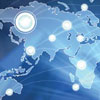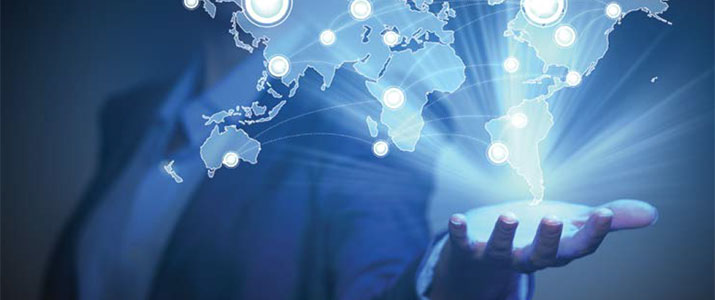
At a Global Level
The benefits of centralizing and standardizing security systems fall to the bottom line
- By Renae Leary
- Sep 01, 2013
 Whether it’s the bank that started with one location or a
technology company that started in the founder’s proverbial
garage, every global company began small. It is
through scalability that companies are able to become
global by replicating local growth in order to achieve success
in many locations or across a broader geographic area. Even as businesses
scale a successful formula, they have to be mindful of the localized differences
from one market to the next. For example, a restaurant chain must adapt to local
palates while an automobile manufacturer must create vehicles that fit differing
preferences or regulations.
Whether it’s the bank that started with one location or a
technology company that started in the founder’s proverbial
garage, every global company began small. It is
through scalability that companies are able to become
global by replicating local growth in order to achieve success
in many locations or across a broader geographic area. Even as businesses
scale a successful formula, they have to be mindful of the localized differences
from one market to the next. For example, a restaurant chain must adapt to local
palates while an automobile manufacturer must create vehicles that fit differing
preferences or regulations.
This same concept applies to securing global companies. While adapting to
geographical and demographic differences, security must attain a worldwide standard
of safety and risk management consistent with the effective operation of the
enterprise. Security technology can address both needs by adapting to and supporting
localized requirements, while maintaining this standard.
Most global companies are looking to achieve fast growth in the coming decades,
and the best opportunities for that growth come in new markets, where
security can be an even bigger concern than in developed areas. You have to go
where the growth is because effective security to protect the business wherever it
goes and the facilities wherever they are built will continue to be paramount for
global enterprises. Effective security will make it possible for companies to enter
new locations safely, enabling continued growth into developing markets.
Many global companies seek to centralize the management of their key functions
while ensuring adherence to a corporate-wide standard, and security is no
different since centralized management can be the most efficient and cost-effective
approach to security.
Let’s look at ways corporate security
systems can be centralized and
standardized on a global scale while
meeting localized needs, and how the
resulting cost efficiencies go to the bottom
line.
Technology Makes the World Smaller
Communications and networking technologies
help make the world a smaller
place by simplifying the transfer of information
around the globe. This helps
facilitate the operation of a worldwide
marketplace by easily crossing national
boundaries and reaching every corner
of the world.
In the case of global companies, the
easy flow of information enables more
efficient operation, and greater standardization
and compliance.
With security, integrated technology
systems can bring together disparate
security processes and systems across
cities, countries and continents. Global
customers benefit from centralized
monitoring, system management, and
streamlined installations and services,
leading to increased efficiency. Just as
the efficiencies of operation contribute
to the success of a global enterprise, so
do the efficiencies of worldwide, implemented,
security technology to promote
better protection of that enterprise.
Instead of dealing with variable information
from disparate systems all
over the world, security end users can
now manage their systems centrally
from one location, anywhere in the
world with network access. Global integration
puts information at their fingertips
as the benefits are reflected in the
improved efficiency and effectiveness of
technology systems.
Operational Efficiencies Saves Money
The need to reduce costs is a given, so
multinational clients are optimizing
operational budgets in every possible
area. Security has to do its part, and
the cost-effective application of video
surveillance, video monitoring, access
control and security services reflect
the broader cost-consciousness of the
enterprise. Perhaps most importantly,
lower costs must not be achieved by
compromising equipment quality or
system performance. The new standard
is to combine cost-effectiveness with
superior performance. Global end users
today demand nothing less.
Economies of scale provide an important
contribution to cost effectiveness.
Large, unified systems are less
expensive to operate than multiple,
non-standardized systems. Security
systems can now operate on global
platforms that control multiple databases
and systems from a single point,
giving greater efficiency, simplicity and
ease of use. This approach allows for a
reduction in software licensing fees, a
significant cost savings for a large enterprise
organization.
In addition, centralized security
systems also need fewer operators. Because
smart technology provides tools
to make operators more efficient and
productive, companies can reduce the
number of people they need to manage
security. This is another way to save
costs without compromising protection.
Global security systems make another
contribution to profitability by
offering greater protection for people,
facilities and assets worldwide. This
is perhaps the biggest contribution of
security technology to the enterprise’s
bottom line. Because systems help to
manage risk and respond more quickly
to potential security threats, the convergence
of multiple systems saves time
and effort. A well-integrated, global security
system pays for itself many times
over by neutralizing risk and responding
to events to minimize their impact.
Should an event occur, security systems
provide important information
and evidence about the event to aid in
prosecution or provide insight into how
to prevent similar events in the future.
For example, an event can trigger immediate
video coverage in real time,
and it is simultaneously accessible to
management and security professionals
throughout the company. This information
is power for global companies
in terms of any security system’s return
on investment (ROI) as integrated systems
provide information to empower
more effective management of worldwide
security.
Beyond the security department,
integration with other enterprise systems
is another way security technology
can save costs for the enterprise.
For instance, integration of access
control with building management can
allow lights and air-conditioning to be
activated in a specific office only when
an employee swipes a card during offhours.
Even small efficiencies can pay
off big, when considering the benefit(s)
on a global scale.
Technology Boosts Operation and Success
Multiple factors of operation can impact
the security requirements of any
company; but, this is especially true of
large companies, which face operational
factors that impact security needs
in a variety of ways around the world.
Therefore, another factor impacting
security is the need to comply with a
range of regulatory environments.
In the United States, for example,
chemical-related companies are required
to adhere to federal CFATS
standards, which include the need to
meet 18 published, risk-based, performance
standards. If a company doesn’t
comply, they face having to pay penalties
to the government. CFATS stands
for Chemical Facility Anti-Terrorism
Standards, and it’s just a sampling of
the alphabet soup of regulations that
impact companies in the United States
alone. Other examples are HIPAA (for
the medical community), NERC/FERC
(for utility companies) and Sarbanes-
Oxley (SOX, governing accountability
of public companies).
In addition, the European Union
has its own long list of regulatory requirements,
and any company with
global locations faces a seemingly
endless stream of varied and assorted
requirements to meet, such as the international
ISO 27000 (related to information
security).
Even regulations that are not specific
to security can impact how security operates,
and technology systems must be
able to conform to their requirements.
By converging security and other
technology systems with overall operations,
companies can simplify regulatory
compliance worldwide. Solutions
can help manage compliance, a huge
cost that is central to global success.
The data from security technologies,
which is increasingly easy to integrate
with other platforms, can add value
throughout the enterprise. More information
and transparency into company
operations enables more efficient operation
related to compliance. Thus, any
problems can be identified earlier and
more easily, helping to minimize the expense
of dealing with them.
From Multinational to Truly Global
A lot has been written about what it
takes to be a true “global” company.
Management gurus sometimes draw a
distinction between a “multinational”
and “global” company with the difference
between the two being how unified
the company is on a global basis.
For example, a multinational company
might have locations or facilities
in many countries, but each location
might function independently. In contrast,
a global company tends to have
a more unified corporate culture and a
similar set of processes and functions
around the world, effectively making it
a single, worldwide entity.
This same paradigm plays out in
the security department of global companies.
Legacy technology differences
deployed at various locations tend to
complicate the challenge, as does the
trend toward mergers and acquisitions, with each new asset coming with
its own specialized security needs and
installed base of technologies. Multinational
companies tend to want to operate
more like global companies, and
unifying, standardizing and centralizing
the security function is a big part of
the process.
As many multinational companies
work toward being more global by
strengthening the internal corporate
culture elements that tend to unify
the many locations into one, they often
take a step back to analyze how
the company has developed piecemeal
over the years and to reimagine how
the company should be structured to
address the global market.
The same can happen with security
systems.
By reimagining and re-engineering
its security technologies on a global
scale, an enterprise—with the help of
a global systems integrator who is able
to address the broad enterprise needs
of the company and work to combine
systems around the world and create a
unified face of security for the enterprise—
can add immense value to the
bottom line and contribute to cost savings
in the process.
Meeting Higher Demands of Global Companies
Combining cost savings and better
security are critical to optimizing the
operation of global companies and
protecting their people, facilities and
assets. Technology stands ready to
enable even the largest companies to
maximize their security benefits while
minimizing costs.
Thoughtful implementation of technology,
in the broader context of overall
company operations, provides a path
to realize the benefits at less cost; however,
technology must address localized
security concerns while achieving and
maintaining a worldwide standard of
protection. It must interface and interoperate
with other information systems
to maximize its value and extend its
usefulness to a variety of operationsrelated
goals. It must also adhere to
corporate spending austerity while contributing
to corporate wealth and paving
the way for future expansion.
Delivering networked access control
and video management systems for
global corporations is a challenging task.
Providers must deliver a vast network of
geographic coverage, a robust centralized
project management team well versed in
different regional regulations and cultures,
and a worldwide monitoring and
service organization to meet customer
needs virtually anywhere in the world.
Most important is a global support network
to provide global proposal, installation
and service coordination to further
help reduce project cycle times while
ensuring high-quality implementations.
When all these capabilities come together,
worldwide businesses can partner
with a technology and service provider
to realize significant cost efficiencies and
streamlined security
operations across the
world.
This article originally appeared in the September 2013 issue of Security Today.